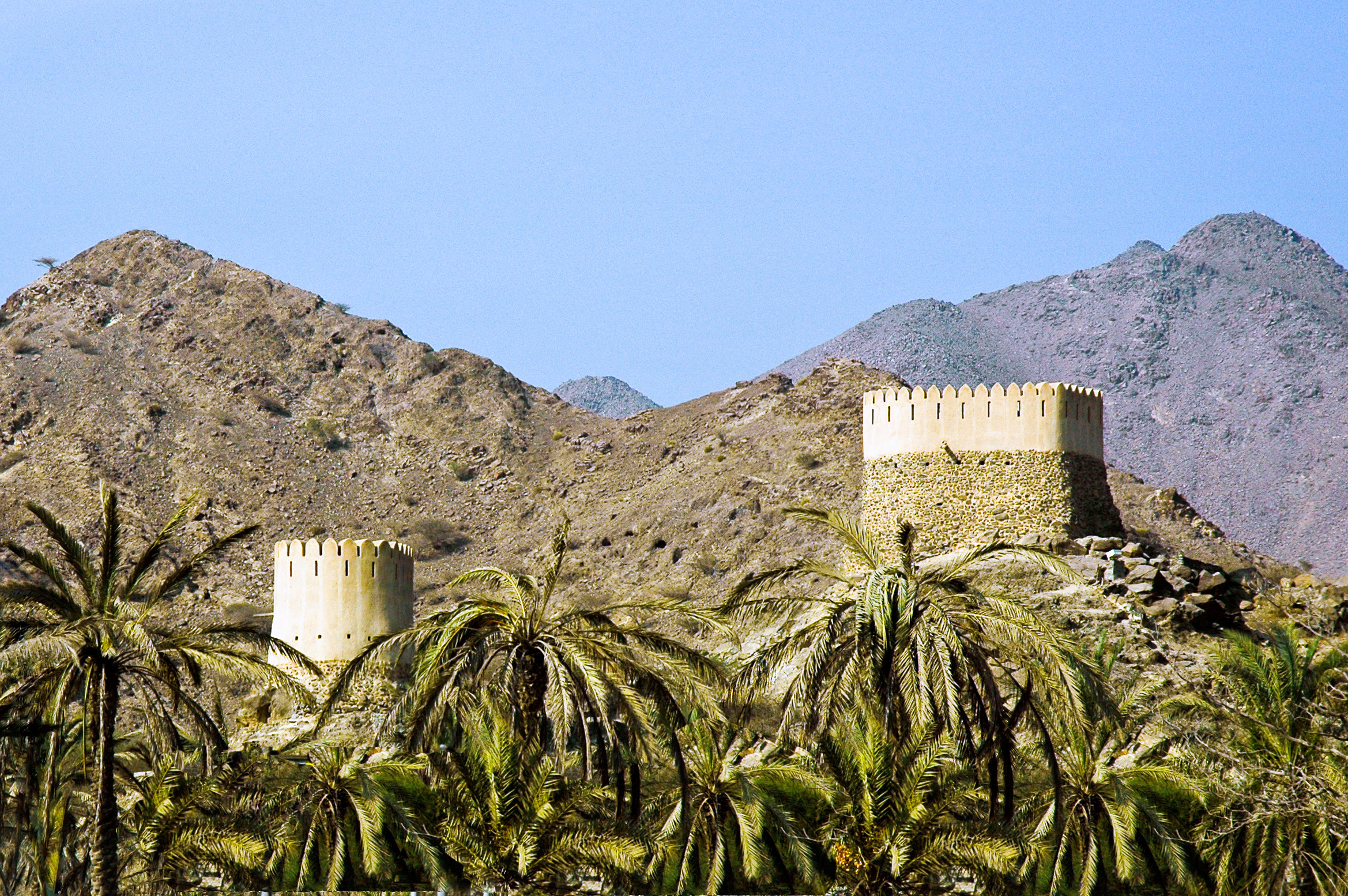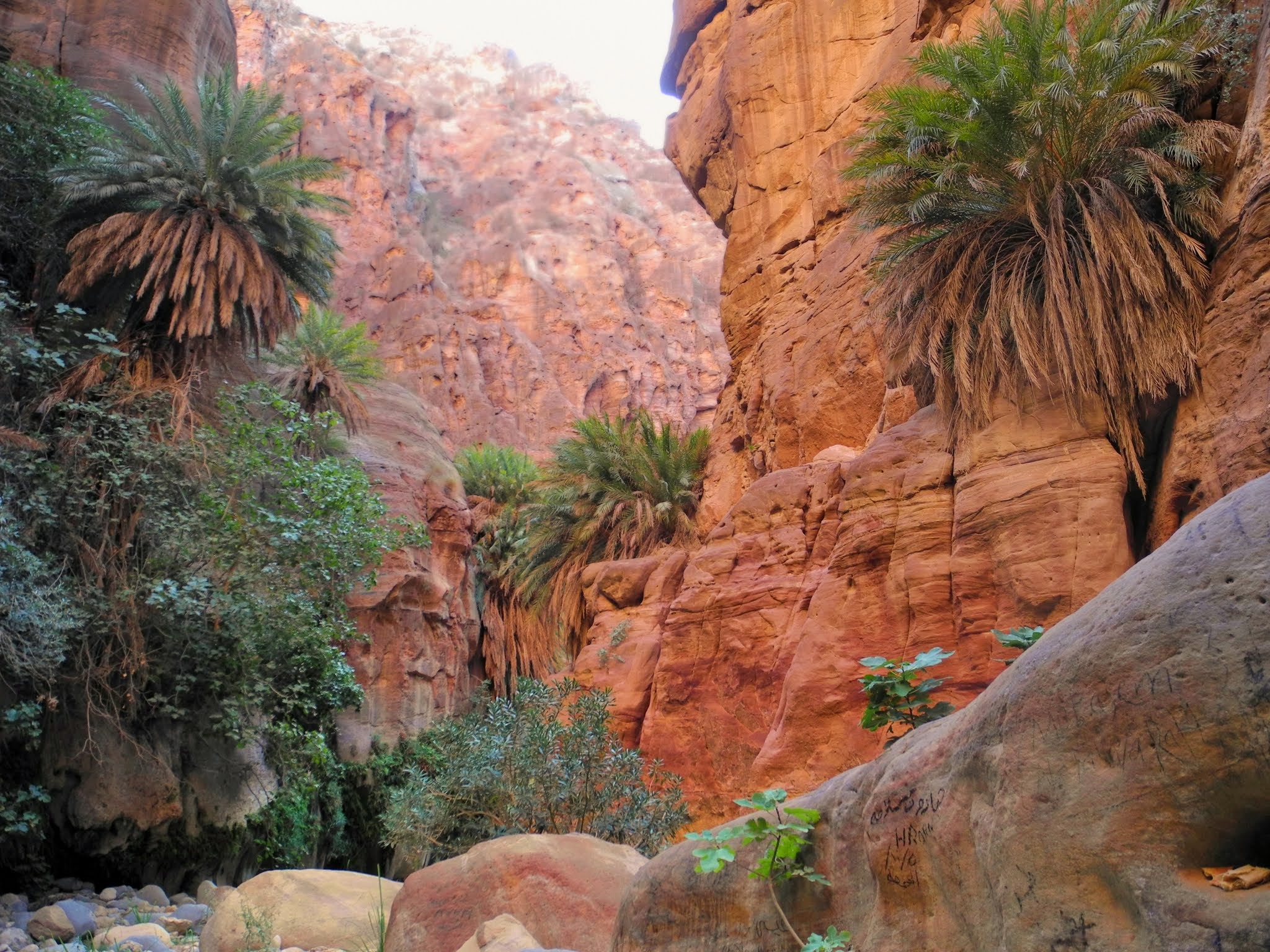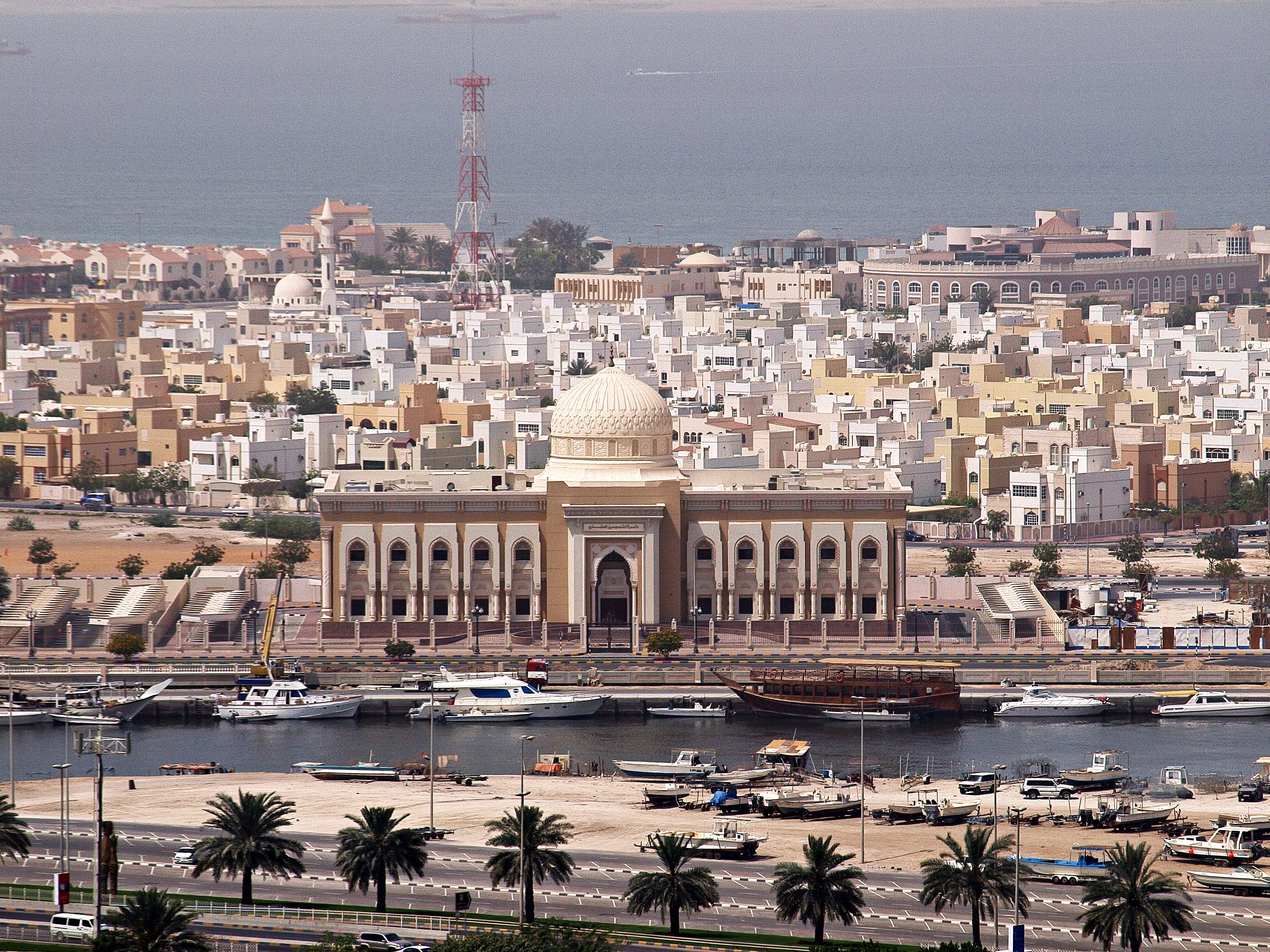|
Siji
Wadi Siji is a seasonal watercourse in the Hajar Mountains of Fujairah, in the United Arab Emirates. The wadi runs from the Sharjah city of Dhaid to the mountain town of Masafi, where it meets the Wadi Ham and Wadi Abadila. It has long been a strategic route connecting the interior and East Coast of the UAE. Extent The wadi is dammed at the village of Siji, where the Wadi Siji 'Old Dam' has a water storage capacity of 1.2 million cubic metres. The dam, constructed in the 1970s, is 10m high and 500m wide. Like many wadis in the Hajar Mountains, Wadi Siji is prone to seasonal flash floods and high water levels with at times tragic consequences. In 2001, UAE President Sheikh Zayed Al Nahyan ordered the construction of a further three dams at Siji, providing water resources for 312 homes and 210 farms in the area as part of a Dhs250 million national water infrastructure development project. The area is a popular ecotourism destination. The village is the location of the Siji ... [...More Info...] [...Related Items...] OR: [Wikipedia] [Google] [Baidu] |
Dhaid
Dhaid, or Al Dhaid ( ar, ٱلذَّيْد, Adh-Dhayd), is the capital of the Central Region of the Emirate of Sharjah in the United Arab Emirates. An oasis town, it has extensive irrigated date palm plantations with water channelled from the nearby Hajar mountains, at least in part through ancient tunnels dug for that purpose, known as '' aflāj'' in Arabic (''falaj'' in the singular). Dhaid has long occupied a strategic location in the mouth of the important Wadi Siji. History and prehistory An archaeological site discovered here in 2015 shows evidence of habitation by humans going back hundreds of thousands of years to the Stone Age. In particular, awls for piercing holes in the leather of animal hides, scrapers for cleaning leather, and stone axes were found here. At the turn of the 20th century, Dhaid consisted of some 140 houses, owned by sections of the Tanaij, Bani Qitab and Khawatir tribes, including larger houses with mud brick towers. It also had a four-towered Al- ... [...More Info...] [...Related Items...] OR: [Wikipedia] [Google] [Baidu] |
List Of Wadis Of The United Arab Emirates
The United Arab Emirates does not have any permanent rivers, but does have wadis, a permanently or intermittently dry riverbed. This is a list of wadis in United Arab Emirates arranged by drainage basin. Persian Gulf *Dubai Creek is sometimes called a river, but is a saltwater inlet in Dubai * Wadi Bih in Ras Al Khaimah, Dibba and Oman *Wadi Ghalilah in Ras Al Khaimah *Wadi Shaam in Ras Al Khaimah Gulf of Oman * Wadi Abadilah in Fujairah * Wadi Ham in Fujairah * Wadi Hayl in Fujairah * Wadi Helo in Sharjah * Wadi Qor in Ras Al Khaiman *Wadi Saham in Fujairah * Wadi Shawka in Ras Al Khaimah *Wadi Shis in Sharjah * Wadi Siji in Fujairah and Ras Al Khaimah * Wadi Wurayah in Fujairah *Wadi Zikt in Fujairah Interior * Wadi Asimah in Ras Al Khaimah * Wadi Ejili in Ras Al Khaimah * Wadi Esfai in Ras Al Khaimah * Wadi Fara in Ras Al Khaimah * Wadi Maydaq in Fujairah * Wadi Modaynah in Ras Al Khaimah * Wadi Naqab in Ras Al Khaimah * Wadi Sal in Ras Al Khaimah * Wadi Sidr in Fujairah * Wad ... [...More Info...] [...Related Items...] OR: [Wikipedia] [Google] [Baidu] |
United Arab Emirates
The United Arab Emirates (UAE; ar, اَلْإِمَارَات الْعَرَبِيَة الْمُتَحِدَة ), or simply the Emirates ( ar, الِْإمَارَات ), is a country in Western Asia ( The Middle East). It is located at the eastern end of the Arabian Peninsula and shares borders with Oman and Saudi Arabia, while having maritime borders in the Persian Gulf with Qatar and Iran. Abu Dhabi is the nation's capital, while Dubai, the most populous city, is an international hub. The United Arab Emirates is an elective monarchy formed from a federation of seven emirates, consisting of Abu Dhabi (the capital), Ajman, Dubai, Fujairah, Ras Al Khaimah, Sharjah and Umm Al Quwain. Each emirate is governed by an emir and together the emirs form the Federal Supreme Council. The members of the Federal Supreme Council elect a president and vice president from among their members. In practice, the emir of Abu Dhabi serves as president while the ruler of Dub ... [...More Info...] [...Related Items...] OR: [Wikipedia] [Google] [Baidu] |
Ras Al Khaimah
Ras Al Khaimah (RAK) ( ar, رَأْس ٱلْخَيْمَة, historically Julfar) is the largest city and capital of the Emirate of Ras Al Khaimah, United Arab Emirates. It is the sixth-largest city in UAE after Dubai, Abu Dhabi, Sharjah, Al Ain and Ajman. The city is divided by a creek into two parts: old town in the west and Al Nakheel in the east. Etymology The name Ras Al Khaimah means "the headland of the tent". It is reported that the city gained its named after a tent was erected there to facilitate navigation. History The northern area of the city today known as Ras Al Khaimah was previously the location of the important Islamic era settlement and port of Julfar. Ras Al Khaimah has been the site of continuous human habitation for 7,000 years, one of the few places in the country and the world where this is the case. Archaeological evidence has demonstrated that the settlement known as Julfar shifted location over time as harbour channels silted up. Excavations ... [...More Info...] [...Related Items...] OR: [Wikipedia] [Google] [Baidu] |
Al Hajar Mountains
The Hajar Mountains ( ar, جِبَال ٱلْحَجَر, Jibāl al-Ḥajar, ''The Rocky Mountains'' or ''The Stone Mountains'') in northeastern Oman and also the eastern United Arab Emirates are the highest mountain range in the eastern Arabian peninsula. Also known as "Oman Mountains", they separate the low coastal plain of Oman from the high desert plateau, and lie inland from the Gulf of Oman. ''Al'' () means "the", and ''Ḥajar'' () means "stone" or "rock". So ''al-Ḥajar'' () is named as "the stone" or "the rock". Geology Orography and tectonic setting The Hajar Mountains extend for through the UAE and Oman. They are located on the north-east corner of the Arabian Plate, reaching from the Musandam Peninsula through to the east coast of Oman. The range is about wide, with Jabal Shams being the highest peak at 3,009 m (9,872 ft) in the central region of the mountains. Currently, the Arabian Plate is moving north relative to the Eurasian Plate ... [...More Info...] [...Related Items...] OR: [Wikipedia] [Google] [Baidu] |
Emirate Of Fujairah
The Emirate of Fujairah ( ar, إِمَـارَة ٱلْفُجَيْرَة ' ) is one of the seven emirates that make up the United Arab Emirates. The only of the seven with a coastline solely on the Gulf of Oman and none on the Persian Gulf, its capital is Fujairah. History The Emirate of Fujairah, dominated by the ''Sharqiyin'' tribe, sits at the mouth of the important trade route, the '' Wadi Ham'' (which is guarded by the Sharqiyin Al Bithnah Fort), through the mountains to the interior and the Persian Gulf Coast. Known as the ''Shamaliyah'', the east coast of what is now the UAE was subject to Muscat until 1850, when it was annexed by ''Al Qasimi'' of Sharjah, in an agreement made between Sheikh Sultan bin Saqr Al Qasimi and the Sultan of Muscat. The Shamaliyah was governed by Al-Qasimi Wali at Kalba although frequently seceded and in 1901 Sheikh Hamad bin Abdullah Al Sharqi, chief of the Sharqiyin, declared independence from Sharjah. This was recognized by a nu ... [...More Info...] [...Related Items...] OR: [Wikipedia] [Google] [Baidu] |
Wadi
Wadi ( ar, وَادِي, wādī), alternatively ''wād'' ( ar, وَاد), North African Arabic Oued, is the Arabic term traditionally referring to a valley. In some instances, it may refer to a wet ( ephemeral) riverbed that contains water only when heavy rain occurs. Etymology The term ' is very widely found in Arabic toponyms. Some Spanish toponyms are derived from Andalusian Arabic where ' was used to mean a permanent river, for example: Guadalcanal from ''wādī al-qanāl'' ( ar, وَادِي الْقَنَال, "river of refreshment stalls"), Guadalajara from ''wādī al-ḥijārah'' ( ar, وَادِي الْحِجَارَة, "river of stones"), or Guadalquivir, from ''al-wādī al-kabīr'' ( ar, اَلْوَادِي الْكَبِير, "the great river"). General morphology and processes Wadis are located on gently sloping, nearly flat parts of deserts; commonly they begin on the distal portions of alluvial fans and extend to inland sabkhas or dry lakes. In basi ... [...More Info...] [...Related Items...] OR: [Wikipedia] [Google] [Baidu] |
Emirate Of Sharjah
The Emirate of Sharjah (; ar, إِمَارَة ٱلشَّارِقَة ') is one of the emirates of the United Arab Emirates, which covers and has a population of over 1,400,000 (2015). It comprises the capital city of Sharjah, after which it is named, and other minor towns and exclaves such as Kalba', Al Dhaid, Dibba Al-Hisn and Khor Fakkan. The emirate is an absolute monarchy. It has been ruled by Sultan bin Muhammad Al-Qasimi since 1972, except for a six-day period during an attempted coup d'etat by his brother, Sheikh Abdulaziz bin Mohammed Al-Qasimi. History Human settlement in the area covered by the emirate has existed for over 120,000 years, with significant finds made of early axes and stone tools as well as Copper and Iron Age implements in Al Dhaid, Al Thuqeibah, Mileiha, Tell Abraq, Muwailah, Al Madam and Jebel Faya. Archaeological finds in the Mleiha area point to human habitation consistent with the spread of humanity from Africa to the wider world, ... [...More Info...] [...Related Items...] OR: [Wikipedia] [Google] [Baidu] |
Masafi
Masafi ( ar, مسافي) is a village located on the edge of the Hajar Mountains in the United Arab Emirates. It sits at the inland entrance of the Wadi Ham, which runs down to Fujairah City. The border between the emirates of Fujairah and Ras Al Khaimah runs through the town, which houses a barracks used by the United Arab Emirates Armed Forces. Overview Until relatively recently, with the construction of the Sharjah to Kalba road and the 'truck road' between Dibba and the 311 highway at Ras al-Khaimah, the road through Masafi was the only route from the interior to the East Coast of the UAE. The road from the inland town of Dhaid splits at Masafi, leading to Dibba to the north and Fujairah City to the south. A number of excavations point to Bronze Age habitation in Masafi, which has a recently restored (2012) stone and adobe fort, smaller but architecturally similar to the nearby Al Bithnah Fort, also restored as part of the same project. The fort encloses an exceptional exampl ... [...More Info...] [...Related Items...] OR: [Wikipedia] [Google] [Baidu] |
Wadi Ham
Wadi Ham is a wadi, a seasonal watercourse, in the Hajar Mountains of Fujairah and Ras Al Khaimah, United Arab Emirates. The wadi runs from Masafi towards Fujairah City, until it reaches the Wadi Ham Dam and the Gulf of Oman. The wadi is crossed by the Sharjah to Khor Fakkan road north of the village of Daftah, which is in Ras Al Khaimah and traditionally Mazari. The Fujairah village of Al Bithnah and its strategically important fort, Al Bithnah Fort, is on the route. The E 89 Sheikh Maktoum Bin Rashid Al Maktoum Road runs along the length of the wadi between Masafi and Fujairah City. A proposed Etihad Rail line is also planned to run along this route. At Masafi, the Wadi Ham joins the Wadi Abadilah, which runs down to the town of Dibba Al Hisn on the East Coast of the UAE, making Masafi the central point on a crescent-shaped, contiguous waterway that transects the Hajar Mountains. Like many wadis in the Emirates, Wadi Ham has experienced salt water intrusions in the ... [...More Info...] [...Related Items...] OR: [Wikipedia] [Google] [Baidu] |
Wadi Abadilah
Wadi Abadilah is a wadi in Fujairah, United Arab Emirates, which runs North East towards the coast at Dibba. At Masafi, it forms a confluence with the Wadi Ham, which runs South East towards Fujairah City. See also * List of wadis of the United Arab Emirates The United Arab Emirates does not have any permanent rivers, but does have wadis, a permanently or intermittently dry riverbed. This is a list of wadis in United Arab Emirates arranged by drainage basin. Persian Gulf *Dubai Creek is sometimes cal ... References Rivers of the United Arab Emirates Geography of the Emirate of Fujairah {{UnitedArabEmirates-geo-stub ... [...More Info...] [...Related Items...] OR: [Wikipedia] [Google] [Baidu] |
Motivate Publishing
Motivate Media Group (previously known as Motivate Publishing) is a media company based in Dubai, United Arab Emirates. It was founded in 1979 by Ian Fairservice, and today has offices in Abu Dhabi (the capital of the UAE) Saudi, and London. It is operated in partnership between Ian Fairservice and Obaid Al Tayer, who is the chairman of the Al Tayer Group and the UAE’s former Minister of State for Finance. History The company was established with the launch of ''Whats On'', the first English language magazine in the Persian Gulf region. The magazine’s primary readership was budding tourists and the UAE’s expat community. Today, Motivate Media Group publishes a variety of magazines, including ''Emirates Woman'', ''Gulf Business'', ''Campaign Middle East'', and ''Business Traveller Middle East''. Motivate Media Group publishes books on topics related to the Middle East under its Books Arabia division. The company has published books by authors including Sheikh Mohammed bin ... [...More Info...] [...Related Items...] OR: [Wikipedia] [Google] [Baidu] |
.jpg)





